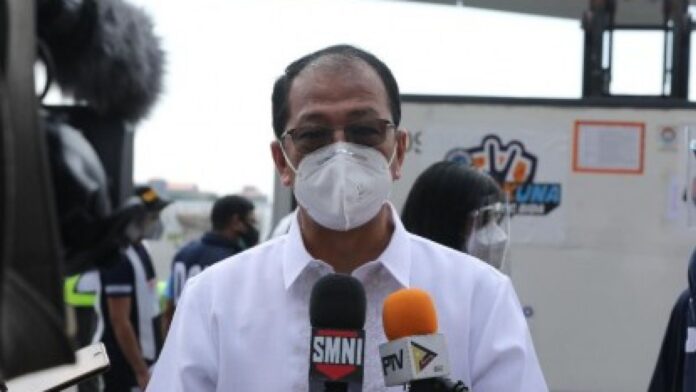The Philippines will soon reach its targeted threshold for population protection as the average daily vaccination rate continues to increase with more deliveries of Covid-19 vaccines arriving, National Task Force (NTF) against Covid-19 chief implementer, Secretary Carlito Galvez Jr., said Thursday.
Galvez, who is also the vaccine czar, cited the average vaccination rate has slightly slowed down to at least 300,000 doses daily in the previous months.
“Ngayon tumataas naman tayo (We are now increasing)–as we have said earlier, that last Friday we were able to accomplish the highest jab [administered] per day to 724,294 [doses],” Galvez told the reporters during the arrival of 896,000 doses of Japan-donated AstraZeneca vaccine at the Ninoy Aquino International Airport Terminal 1 in Parañaque City.
Citing the data from the National Vaccine Operations Center (NVOC), Galvez reported that the Philippines has recorded 667,765 doses administered on Oct. 27 alone.
“Meaning nandun tayo sa ating (we are now in our) threshold and we are very confident na (that) once already started the vaccination of the minors [nationwide], we will be able to increase our capacity, considering that the capacity of the NCR (National Capital Region) is more than 250 [thousand],” he said.
“Once it (NCR) was capacitated by having the vaccination of more or less 1.4 million, we are very, very confident that we can achieve the 1.5 million jab per day,” he added.
The government targets to administer up to 1.5 million doses nationwide, to hit its target to fully inoculate at least 50 percent of the country’s 110 million estimated total population by end of this year.
The Philippines has so far received a total of 99,551,290 doses of Covid-19 jabs.
Galvez, however, cited some challenges in the vaccine deployment in some geographical areas including the critical logistical requirement of highly sensitive vaccines brands such as Pfizer, Moderna, and Gamaleya’s Sputnik V, that require sub-zero temperatures.
“In that factor, most of our municipalities don’t have some sort of stable electricity in their areas. And considering that these vaccines need a storage with stable power supply. The problem is that we will have to plan this just in time deliveries,” he said, noting that a “considerable” delay in the vaccine deployment is possible.
“Those factors make the certain municipalities the lack of confidence to handle these vaccines,” he added.
Galvez said similar reasons have greatly contributed to the downtrend of the country’s vaccination rate during the previous months, including the high number of vaccine hesitancy in the areas that are low-risk to virus infections.
He said the government has gradually overcome these challenges.
“We believed that we can surmount these challenges,” he said.
As of Oct. 27, the Philippines has administered a total of 57,494,154 doses nationwide, with 31,015,126 jabs were given as first doses and 26,479,0128 were second doses.
The average daily vaccination rate stood at 522,272 doses in the last seven days. (PNA)


